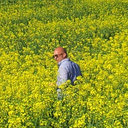Phytochemical, Ecological and Antioxidant Evaluation of Wild Sicilian Thyme: Thymbra capitata (L.) Cav.
Klíčová slova
Abstraktní
In a broad survey conducted throughout the Sicily region, 45 different sites were identified where thyme grows wild. All the biotypes collected were classified as Thymbra capitata (L.) Cav. (syn. Thymus capitatus (L.) Hoffmanns. & Link). Cluster analysis based on the main morphological characteristics of the plant led to the division of the biotypes into 3 major groups. All samples were analyzed for their secondary phytochemical metabolites identified in the extracts and the essential oils. LC-UV-DAD/ESI-MS and GC-FID/GC-MS have been applied to characterize the extracts and the essential oils, respectively. In the extracts, 15 flavonoid derivatives with taxifolin-di-O-glucoside and thymusin as main components, and 2 organic acids, with a large predominance of rosmarinic acid, were identified. On the whole 37 compounds were fully characterized in the essential oils, carvacrol was identified as the main component with an average value of 73.93%. The total phenol content and the antioxidant activity of all phytochemical complexes were determined with the Folin-Ciocalteu (FC) assay, the UV radiation-induced peroxidation in liposomal membranes (UV-IP test), and the scavenging activity of superoxide radical (O2∙-).




